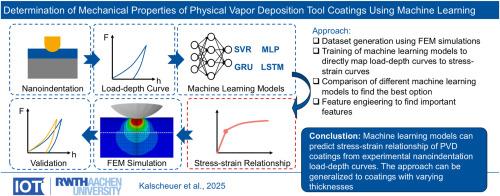Determination of mechanical properties of physical vapor deposition tool coatings using machine learning
IF 6.1
1区 工程技术
Q1 ENGINEERING, MECHANICAL
引用次数: 0
Abstract
The wear resistance of physical vapor deposition (PVD) coatings is heavily influenced by their elastic and plastic properties. These properties serve as essential inputs for finite element method (FEM) simulations of the thermomechanical load experienced by the coating during the cutting process to predict tool wear, including the elastic modulus for the characterization of elastic properties and parameters of the Ludwik-Hollomon model for plastic behavior. In this study, machine learning models are developed to directly map load-depth curves from nanoindentation to elastic modulus and Ludwik-Hollomon parameters of the coating. A FEM simulation model of nanoindentation is employed to generate a dataset comprising load-depth curves from a wide range of input mechanical properties. For each definition of mechanical properties, simulations of nanoindentation at two different indentation forces are run to generate the dataset. Several machine learning models including support vector regression (SVR), multilayer perceptron (MLP), long short-term memory (LSTM) and gated recurrent unit (GRU) are then trained, validated and compared using this dataset. The inputs to these models consist of simulated load-depth curves, with the target being mechanical properties of coatings. Among these machine learning models, SVR achieves the best accuracy for predicting elastic modulus and GRU achieves the best accuracy for predicting plastic properties. Ultimately, a hybrid model combining SVR and GRU is used to predict mechanical properties of TiAlCrN coatings using experimental load-depth curves. FEM simulations using the predicted mechanical properties show good alignment with nanoindentation experiments at two different forces. The determined properties can serve as input parameters for FEM models simulating thermomechanical load during the cutting process.

用机器学习测定物理气相沉积工具涂层的机械性能
物理气相沉积(PVD)涂层的耐磨性在很大程度上取决于其弹塑性性能。这些性能是切削过程中涂层所经历的热机械载荷的有限元模拟的基本输入,用于预测刀具磨损,包括表征弹性性能的弹性模量和表征塑性行为的Ludwik-Hollomon模型参数。在本研究中,开发了机器学习模型,直接将负载深度曲线从纳米压痕映射到涂层的弹性模量和Ludwik-Hollomon参数。采用纳米压痕有限元模拟模型,从大范围的输入力学性能出发,生成了包含载荷-深度曲线的数据集。对于每一个力学特性的定义,在两种不同压痕力下的纳米压痕模拟运行以生成数据集。然后使用该数据集训练、验证和比较几个机器学习模型,包括支持向量回归(SVR)、多层感知器(MLP)、长短期记忆(LSTM)和门控循环单元(GRU)。这些模型的输入由模拟的载荷-深度曲线组成,目标是涂层的力学性能。在这些机器学习模型中,SVR在预测弹性模量方面达到了最好的精度,GRU在预测塑性性能方面达到了最好的精度。最后,采用SVR和GRU相结合的混合模型,利用实验载荷-深度曲线预测TiAlCrN涂层的力学性能。利用预测力学性能的有限元模拟结果表明,在两种不同的力下,纳米压痕实验结果与预测力学性能结果吻合良好。所确定的性能可以作为模拟切削过程中热机械载荷的有限元模型的输入参数。
本文章由计算机程序翻译,如有差异,请以英文原文为准。
求助全文
约1分钟内获得全文
求助全文
来源期刊

Wear
工程技术-材料科学:综合
CiteScore
8.80
自引率
8.00%
发文量
280
审稿时长
47 days
期刊介绍:
Wear journal is dedicated to the advancement of basic and applied knowledge concerning the nature of wear of materials. Broadly, topics of interest range from development of fundamental understanding of the mechanisms of wear to innovative solutions to practical engineering problems. Authors of experimental studies are expected to comment on the repeatability of the data, and whenever possible, conduct multiple measurements under similar testing conditions. Further, Wear embraces the highest standards of professional ethics, and the detection of matching content, either in written or graphical form, from other publications by the current authors or by others, may result in rejection.
 求助内容:
求助内容: 应助结果提醒方式:
应助结果提醒方式:


